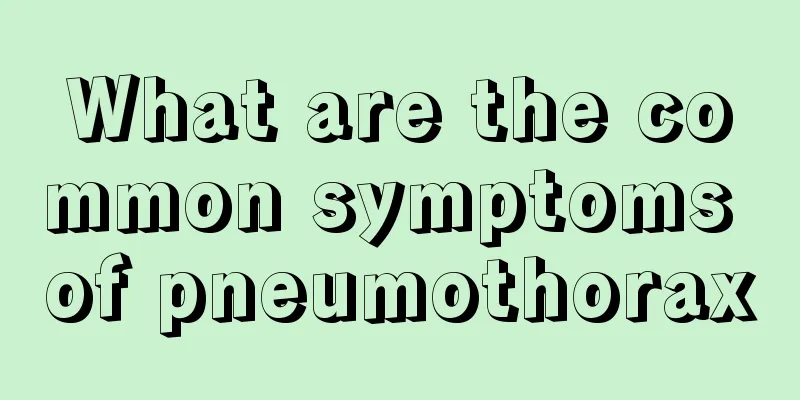What are the common symptoms of pneumothorax

|
Pneumothorax is a symptom that is relatively harmful. When pneumothorax occurs, the onset is relatively rapid and can cause the patient to have severe coughing, difficulty breathing, chest pain and other symptoms. When the disease is more serious, it is also prone to hemothorax, which can cause increased bleeding in the patient, a drop in blood pressure, and cold limbs, posing a great threat to the patient's life safety. 1. Difficulty breathing When pneumothorax occurs, patients will experience dyspnea, the severity of which is related to the course of the attack, the degree of lung compression and the original lung function status. Young patients with normal respiratory function may not have obvious dyspnea. Even if the lungs are compressed by >80%, they may only feel slight chest tightness during activities. However, elderly patients with chronic obstructive pulmonary emphysema may have obvious dyspnea even if the lungs are slightly compressed. In acute pneumothorax, the symptoms may be more obvious, while in chronic pneumothorax, the healthy lung can compensatory expand and the clinical symptoms may be milder. 2. Irritating cough Spontaneous pneumothorax occasionally causes an irritating cough. 3. Chest pain Sudden sharp stabbing and cutting pain often occurs when pneumothorax occurs. It has nothing to do with the sudden rupture of the bullae and the degree of lung compression, but may be related to increased pressure in the pleural cavity and stretching of the parietal pleura. The location of pain is uncertain and may be confined to the chest, or it may radiate to the shoulders, back, and upper abdomen. When significant mediastinal emphysema is present, persistent retrosternal pain may occur. Pain is the most common complaint of patients with pneumothorax and, in mild cases, may be the only symptom. 4. Other symptoms When pneumothorax is combined with hemothorax, if the amount of bleeding is heavy, the patient will experience palpitations, low blood pressure, cold limbs, etc. The above is an introduction to the symptoms of pneumothorax. Do you understand them all? After understanding this, if we find ourselves suffering from the above symptoms in our daily life, we should go to the hospital for diagnosis and treatment in time to avoid worsening of the condition. Finally, I wish you good health! |
<<: What are the signs of intestinal polyps?
>>: What are the ways of transmission of botulism toxin
Recommend
What can I use to wash off oil stains
Oil stains are what people often call grease stai...
Why are teeth sensitive after teeth cleaning?
With the continuous changes of the times, people ...
What to do if you have mild gas poisoning
In life, people will inevitably encounter some si...
What are the early symptoms of lung cancer in the elderly? Dietary methods for lung cancer in the elderly
The immunity of the elderly is relatively low, an...
How is a person's aura cultivated
The aura formed by a person is related to many fa...
How much do you know about the treatment of cardia cancer?
Chemotherapy for cardiac cancer is generally suit...
Is it good to wear knee pads when running
In life, many people particularly like the sport ...
The difference between Botox and hyaluronic acid
As people age, face various pressures in life and...
Experts analyze the drinking factor in the causes of colorectal cancer
Colorectal cancer is caused by many factors. We m...
Purple sweet potato steamed bun calories
Purple sweet potato is a food that can be used as...
The role of hydrolyzed collagen
If you pay attention to taking care of your skin,...
Will a baby's body temperature rise when feeding?
As we all know, human body temperature is affecte...
What's the matter with white hair growing on the pubic area
Women also grow some pubic hair on their genitals...
How does body moisture come from_What causes excessive body moisture
People nowadays have irregular work and rest sche...
Which hospital should I go to for ovarian tumor
Choosing a specialized hospital is very necessary...









